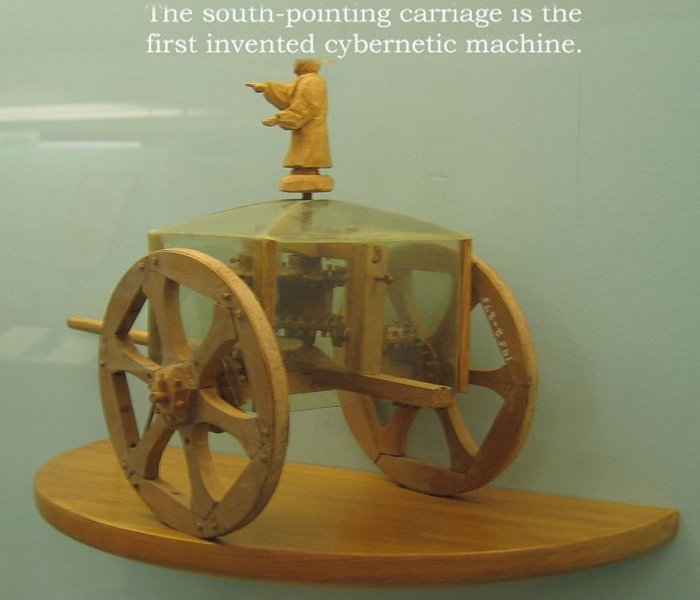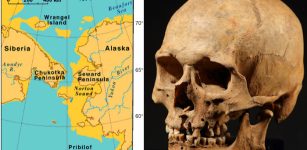Remarkable South-Pointing Chariot – Ancient Cybernetic Machine Invented 1,700 Years Ago Is An Engineering Masterpiece
A. Sutherland - AncientPages.com - It is almost wrong to refer to this engineering masterpiece as ancient or primitive. The first known cybernetic machine was invented already 1,700 years ago.
The device comes from the land of many remarkable inventions, namely ancient China. Although the object was called "south-pointing carriage", it had no connection with a magnetic compass.

Exhibit in the Science Museum in London, England. This conjectural model chariot incorporates a differential gear. Image via wikipedia
In the very interesting book The Genius of China: 3,000 Years of Science, Discovery, and Invention, author and researcher Robert Temple describes the device as a "large carriage, 3.3 metres long, 3.3 metres deep, and 2.75 metres wide, surmounted by a jade statue of an "immortal" a sage who had achieved immortality.
The figure's arm was raised, pointing ahead, and it always faced towards the south, no matter which way the carriage turned. Even if the road were circular, the jade figure would rotate, keeping the finger-pointing in the same direction."
It is unclear when exactly the device was created. We know with certainty the object existed in the third century AD. This machine may have been invented even earlier, indeed, as much as 1,200 years earlier.
An official history for 500 AD describes how: "The south-pointing carriage was first constructed by the Duke of Zhou [beginning of the first millennium BC] as a means of conducting home wards certain envoys who had arrived from a great distance beyond the frontiers. The country was a boundless plain in which people ¡ost their bearings as to east and west, so the Duke caused this vehicle to be made in order that the ambassadors should be able to distinguish north and south."
If this information is correct, the invention would date from about 1030 BC. But Needham suspects that the word "carriage" was inserted in this account by scribes and that what is being described is a "southpointer", that is, a compass.
The Chinese scholar Zhang Heng (A.D. 78 - 139) who was one of the world's first scientists to propose that the universe is infinite in both space and time and also the creator of the first seismograph has sometimes been credited with building the south-pointing carriage.
However, according to Joseph Needham, a British historian of Chinese science and technology, is director of the Needham Research Institute in Cambridge, England it is unlikely Zhang Heng constructed the first cybernetic machine.

A model reconstruction of a "south-pointing carriage" based on a description dating from the 3rd century AD.
This is the engineering work of an unknown ancient person whose identity remains a secret. Who was he or she? Perhaps there is a clue to solving this mystery.
Needhman suggests that the famous mechanical engineer Ma Jun who lived during the Three Kingdoms era of China was the inventor and builder of the south-pointing carriage. Among many things, Ma Jun invented an intricate hydraulic-powered, mechanical-operated puppet theatre, improved silk loom and constructed square-pallet chain pumps meant for irrigation.
Joseph Needham describes Ma Jun's mechanical theatre in a passage taken from the Sanguo Zhi, Records of the Three Kingdoms:
Certain persons offered to the emperor a theatre of puppets, which could be set up in various scenes, but all motionless.
The emperor asked whether they could be made to move, and Ma Jun said that they could. The emperor asked whether it could be possible to make the whole thing more ingenious, and again Ma Jun said yes, and accepted the command to do it.
See also:
Zhang Heng Seismograph Could Record Earth’s Dangerous Movements
Magnetic Compass Was Invented In Ancient China
Highly Advanced Robots In Ancient China
He took a large piece of wood and fashioned it into the shape of a wheel which rotated in a horizontal position by the power of unseen water. Then, he arranged images of singing-girls which played music and danced, and when (a particular) puppet came upon the scene, other wooden men beat drums and blew upon flutes. Ma Jun also made a mountain with wooden images dancing on balls, throwing swords about, hanging upside down on rope ladders, and generally behaving in an assured and easy manner. Government officials were in their offices, pounding and grinding was going on, cocks were fighting, and all were continually changing and moving ingeniously with a hundred variations.
Now let's return back to the subject of the remarkable south-pointing carriage. If the machine did not use a magnetic compass, how did it work?
According to Temple, the device "had a train of differential gears, similar to those in a modern automobile.
Perhaps the function of a differential gear should be explained as follows.
When a wheeled vehicle is turning a corner the wheels on opposite sides of the vehicle are clearly going to need to turn at different rates since the near side is traveling a shorter distance than the far side.
With a hand-cart or horse-drawn carriage, this may not pose such problems. But when a vehicle has power being applied to the axle to make the wheels turn, how is it possible for one wheel to be permitted to speed up a little, and the other slow down a little, on the same axle?
This is made possible only by an ingenious combination of gear wheels and flywheels: the differential gear."
The precision needed in the construction of the south-pointing carriage almost defies belief. For the outside road wheels alone, Needham points out, J. Coales, in The Historical and Scientific Background of Automation, "has calculated that a difference of only one percent between the wheel circumferences would lead to a change of direction of the pointing figure of as much as 90 percent in a distance only fifty times that between the two wheels."
This was because the carriage would veer more and more to one side if one wheel were smaller (relative slip). So that for this south-pointing carriage, the size of the road wheels had to be accurate to a margin of error far less than one percent, and a commensurate accuracy in size of gear wheels would have been necessary.
This points to the engineering of such a high order that we must admit it is a genuine ancient masterpiece!
Written by A. Sutherland - AncientPages.com Senior Staff Writer
Copyright © AncientPages.com All rights reserved. This material may not be published, broadcast, rewritten or redistributed in whole or part without the express written permission of AncientPages.com
More From Ancient Pages
-
 Race Against Time: Crucial Expedition To Delve Into Bouldnor Cliff, Europe’s Mesolithic Underwater Stone Age Site
Underwater Discoveries | Apr 28, 2024
Race Against Time: Crucial Expedition To Delve Into Bouldnor Cliff, Europe’s Mesolithic Underwater Stone Age Site
Underwater Discoveries | Apr 28, 2024 -
 Ruins Of The Ancient City Of Palmyra Documented – What Remains After The Fall Of The Assad Regime
Archaeology | Feb 14, 2025
Ruins Of The Ancient City Of Palmyra Documented – What Remains After The Fall Of The Assad Regime
Archaeology | Feb 14, 2025 -
 3,500-Year-Old Tomb Discovered In Luxor – Who Is The Royal Buried Inside?
Archaeology | Jan 16, 2023
3,500-Year-Old Tomb Discovered In Luxor – Who Is The Royal Buried Inside?
Archaeology | Jan 16, 2023 -
 Judahite Shrine Of Biblical Arad Reveals Ancient Use Of Cannabis And Frankincense
Archaeology | Jun 2, 2020
Judahite Shrine Of Biblical Arad Reveals Ancient Use Of Cannabis And Frankincense
Archaeology | Jun 2, 2020 -
 Vikramashila: India’s Main Intellectual And Learning Center Of Tantric Buddhism
News | Sep 19, 2015
Vikramashila: India’s Main Intellectual And Learning Center Of Tantric Buddhism
News | Sep 19, 2015 -
 What 12 Ancient Skeletons Discovered In A Mysterious Tomb In Petra Could Tell Us About The Ancient City
Featured Stories | Oct 25, 2024
What 12 Ancient Skeletons Discovered In A Mysterious Tomb In Petra Could Tell Us About The Ancient City
Featured Stories | Oct 25, 2024 -
 Runes: Facts And History About Odin’s Secret Language
Ancient History Facts | Jan 27, 2016
Runes: Facts And History About Odin’s Secret Language
Ancient History Facts | Jan 27, 2016 -
 Massive Ancient Fortifications Reveal Poznan Was Poland’s First Capital
Archaeology | Jul 2, 2020
Massive Ancient Fortifications Reveal Poznan Was Poland’s First Capital
Archaeology | Jul 2, 2020 -
 Abydos: One Of The Most Important Cities Of Ancient Egypt
Featured Stories | Jul 15, 2016
Abydos: One Of The Most Important Cities Of Ancient Egypt
Featured Stories | Jul 15, 2016 -
 Mysterious Ancient Human ‘Ghost’ Species Discovered With Help Of Saliva
Archaeology | Jul 25, 2017
Mysterious Ancient Human ‘Ghost’ Species Discovered With Help Of Saliva
Archaeology | Jul 25, 2017 -
 Rare And Unusual Post-Medieval Lead Doll Found In Long Whatton, UK By Mudlarker
Archaeology | Jun 24, 2024
Rare And Unusual Post-Medieval Lead Doll Found In Long Whatton, UK By Mudlarker
Archaeology | Jun 24, 2024 -
 Remarkable Discovery Of Unusual “Hammer Of Thor” Finally Solves An Ancient Mystery
Archaeology | Jul 2, 2014
Remarkable Discovery Of Unusual “Hammer Of Thor” Finally Solves An Ancient Mystery
Archaeology | Jul 2, 2014 -
 Ancient DNA Reveals Migration From North America Across The Bering Sea And Unknown Prehistoric People In Siberia
Archaeology | Jan 12, 2023
Ancient DNA Reveals Migration From North America Across The Bering Sea And Unknown Prehistoric People In Siberia
Archaeology | Jan 12, 2023 -
 Ancient Alaskans Were Freshwater Fishers – Earliest Evidence Found
Archaeology | Jun 19, 2023
Ancient Alaskans Were Freshwater Fishers – Earliest Evidence Found
Archaeology | Jun 19, 2023 -
 Enigmatic Ale’s Stones – Sweden’s Megalithic Ship-Like Formation
Featured Stories | Jan 17, 2023
Enigmatic Ale’s Stones – Sweden’s Megalithic Ship-Like Formation
Featured Stories | Jan 17, 2023 -
 Rare Artifacts Found In Nottingham’s Mysterious Caves On Display For The First Time
Archaeology | Feb 7, 2024
Rare Artifacts Found In Nottingham’s Mysterious Caves On Display For The First Time
Archaeology | Feb 7, 2024 -
 7,000-Year-Old ‘Immortal City’ Of Misis – Excavations Shed Light On Its Fall
Archaeology | Aug 25, 2015
7,000-Year-Old ‘Immortal City’ Of Misis – Excavations Shed Light On Its Fall
Archaeology | Aug 25, 2015 -
 DNA Of 10,000-Year-Old Skeletal Remains And Kinship Of Earliest World Settlers
Archaeology | Apr 21, 2021
DNA Of 10,000-Year-Old Skeletal Remains And Kinship Of Earliest World Settlers
Archaeology | Apr 21, 2021 -
 What Were The Strange Objects Biblical Adam Received From Divine Beings?
Ancient Mysteries | Jul 13, 2020
What Were The Strange Objects Biblical Adam Received From Divine Beings?
Ancient Mysteries | Jul 13, 2020 -
 Treasure Hoard Of Rare Gold Coins From The Crusader Conquest Discovered In Caesarea, Israel
Archaeology | Dec 8, 2020
Treasure Hoard Of Rare Gold Coins From The Crusader Conquest Discovered In Caesarea, Israel
Archaeology | Dec 8, 2020

